#Chainlink #SergeyNazarov #Tokenization #TradFi #DeFi #Cryptocurrency #Blockchain #RealWorldAssets
In a recent enlightening perspective shared by Sergey Nazarov, the co-founder of Chainlink, a decentralized oracle network that provides real-world data to smart contracts on the blockchain, an intriguing future was outlined for the relationship between traditional finance (TradFi) and decentralized finance (DeFi). Nazarov forecasts a significant shift in the financial landscape, where tokenization – the process of converting rights to an asset into a digital token on a blockchain – is set to become a cornerstone in the evolution of finance. According to him, this transition will not only merge the distinct pathways of TradFi and DeFi but will elevate DeFi to the status of being TradFi’s principal patron.
Tokenization possesses the transformative potential to bridge the current divide between traditional financial institutions and the burgeoning DeFi sector. By converting real-world assets (RWAs) such as real estate, stocks, or bonds into digital tokens, these assets become easily divisible, more accessible, and can be traded on a blockchain, thereby ensuring greater liquidity and efficiency. This concept, as Nazarov suggests, is poised to redefine asset trading and ownership, making it more inclusive and expansive. It’s a shift that promises to greatly expand the crypto market’s value proposition by incorporating a vast array of non-crypto assets, which could eventually surpass the current market cap of cryptocurrencies.
Nazarov’s vision places a strong emphasis on the synergy between TradFi and DeFi, suggesting an impending era where traditional financial entities will increasingly rely on DeFi protocols for their operations. This symbiosis could lead to a profound democratization of finance, where digital tokens act as a vehicle for investment opportunities that were previously out of reach for the average investor due to high entry barriers. This integration could also spell a reduction in transaction costs and an improvement in transaction speeds, further enticing traditional finance players to pivot towards DeFi solutions for their operational needs.
However, the journey towards this integrated future is not without its challenges. Regulatory compliance, interoperability issues, and ensuring robust security measures are pivotal concerns that need addressing to foster trust and widespread adoption among traditional finance institutions. Nonetheless, Nazarov’s foresight into the tokenization of real-world assets heralds a compelling evolution for the financial ecosystem. It underscores a near future where DeFi could indeed become the backbone of financial services, driven by the tokenization trend and sustained by the unique benefits that blockchain technology offers. As the lines between TradFi and DeFi continue to blur, the resulting fusion could herald a new epoch of financial innovation and inclusivity.







Comments are closed.